In our approach to product development, we prioritize the Minimum Viable Product (MVP). However, defining what an MVP is and its purpose might be puzzling for many.
The concept of a Minimum Viable Product often sparks discussion but can also cause confusion. At Talentelgia, understanding the essence of MVP and its role within the product development cycle is crucial. We believe in applying lean startup principles intelligently, aligning them with project specifics to yield tangible benefits in the real-world scenario. This understanding forms the cornerstone of our full-cycle product development approach.
This article sheds light on how we perceive and utilize MVPs at our organization to deliver optimal outcomes for our clients.
What is an MVP?
A minimum viable product (MVP) is a concept derived from Lean Startup methodology, emphasizing the significance of learning during the development of new products. According to Eric Ries, an MVP is essentially the initial version of a new product designed to enable a team to gain the maximum amount of validated learning about customers with minimal effort.
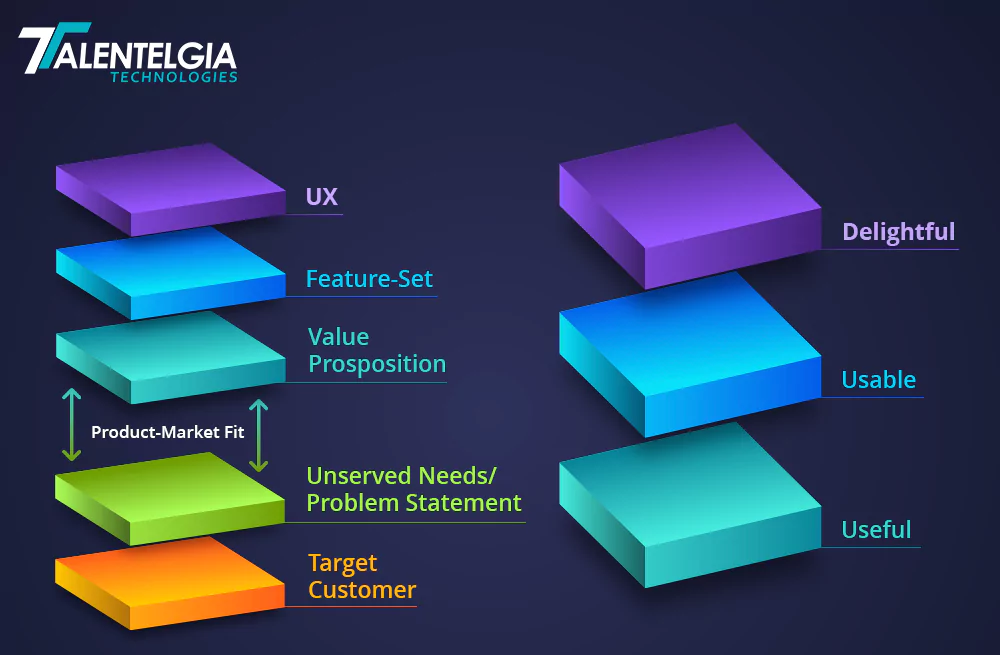
This validated learning primarily revolves around understanding whether customers are genuinely inclined to purchase the product.
The fundamental idea behind the concept of an MVP is to create an actual product, even if it’s as basic as a landing page or a service with a semblance of automation but operates manually in the background. This tangible product can be presented to customers, allowing for the observation of their real-time interactions with the product or service. This approach, relying on actual user behavior, proves more reliable than simply asking people about their hypothetical actions.
In essence, the MVP strategy encourages the development of a tangible product or service that facilitates practical learning about customer preferences and behaviors, steering away from reliance on hypothetical scenarios.
Key Advantages of Developing a Minimum Viable Product (MVP)
Prioritize Core Functionalities
The MVP approach enables a clear focus on the essential functions of your product, allowing cost-effective testing of your business concept. Many product owners tend to incorporate unnecessary features, potentially diverting attention from the specific problem they aim to solve.
Establish a Clear Vision
In the early stages of development, clearly define the core features and customer value of your software. Documenting this primary vision and sharing it with the team helps maintain focus and facilitates better decision-making in the long run.
Foster Early Customer Relationships
Timing is crucial in business. Engaging new users and stakeholders during the initial stages of development, especially with early adopters, helps spread the word about your product and elicits valuable feedback for a customer-oriented approach.
Gain Insight into Customer Needs
Data collected and researched from the target audience, coupled with feedback from early adopters, surpasses assumptions made by business analysts and experienced advisers. Testing the product early allows users to identify preferred functionality, guiding effective development.
Ensure a Clear User Interface
The MVP approach prevents the initial product from being cluttered with unnecessary features, ensuring easy adoption and simplicity of use. This approach also provides an opportunity to explore the functionality of different features independently.
Expedite Release
Developing only core functionality accelerates the product release. Promptly testing key hypotheses and gathering user feedback on both core and desired features is crucial. Procrastination in the release may result in the development of unnecessary features and wasted time on expensive bug fixes.
Embrace Flexibility and Continuous Updates
Building an MVP allows for responsiveness to the dynamic market. The approach accommodates updates and new features based on customer requests, integrating newer technologies to keep the product relevant and competitive.
Develop with Minimal Risks
Recognize that polished large-scale apps require significant time, money, and effort. Many popular software products, including Facebook, Instagram, and Uber, started as MVPs. Developing incrementally minimizes risks and ensures adaptability to market needs.
Why Do You Need A Minimum Viable Product?
In the previous section, we discussed what an MVP development service is. Essentially, it provides a way to address the immediate concerns of users or clients by showcasing the core features.The key point to remember is that additional development and enhancements are only pursued after analyzing user feedback.There’s a common misunderstanding that businesses create MVPs solely to accelerate their time-to-market. However, it’s more common for startups to create the product first and assess its commercial potential.As a result, the primary focus on MVP testing and rapid market analysis takes precedence over development speed.
Process of MVP Development Service in a Nutshell
MVP development is a method for crafting a basic version of your product idea. A minimum viable product (MVP) contains the essential features to address your target customers’ main problem. It’s not a complete product but a prototype for gathering real user feedback and learning from the market.
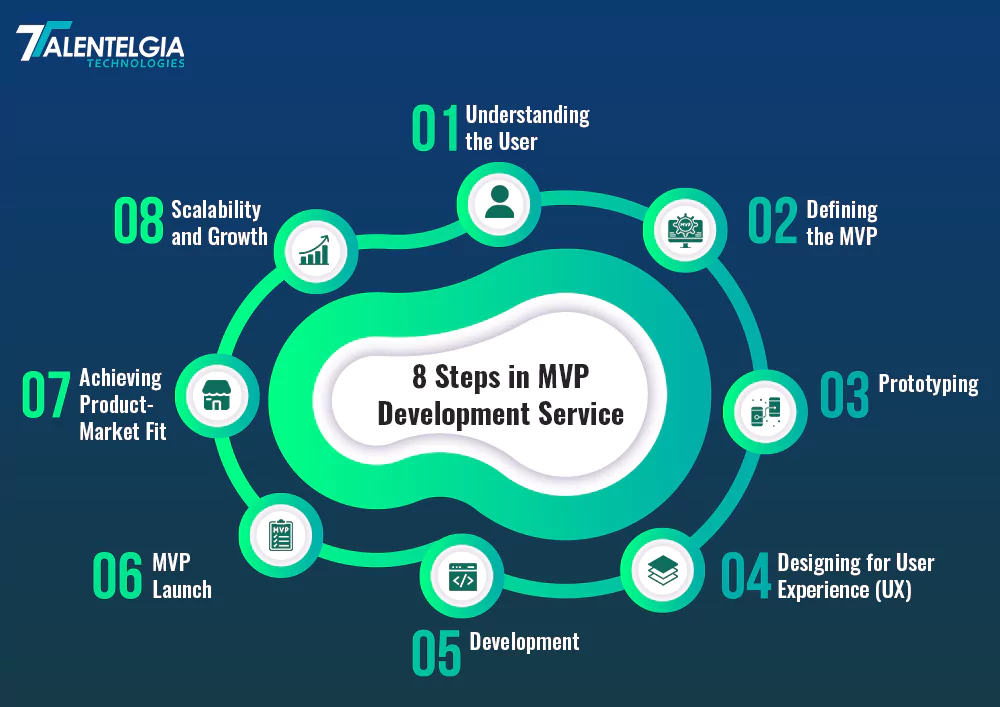
8 Steps to Create a Minimum Viable Product (MVP)
Evaluate and Understand the Market
Commence your MVP development journey by gaining insights into your market and potential customers. Align the development process with the goals of your virtual product and assess whether your ideas resonate with the market. Conduct thorough market research, engage with existing consumers through polls, and offer preset options to understand their preferences.
Define MVP Features for Users
Ensure that your Minimum Viable Product meets the specific demands of your target users. Utilize gathered data to create an MVP that adds significant value to user expectations. Strive to simplify users’ daily lives with the app’s features and products. Identify your target users to determine the optimal features for an effective Minimum Viable Product.
Design with User Experience in Mind
Given that an MVP serves as a testing model for your full-scale app, evaluating its design efficiency is critical. Design from the user’s perspective, keeping simplicity in mind to positively impact user experience. Develop an MVP design that is user-friendly and easily navigable for users of all age groups, ensuring accessibility to the app’s core functionality.
Identify Essential Features
Clarify that your MVP encompasses all essential features required by target users. Despite being a Minimum Viable Product, it should be competent for eventual development. Integrate imperative elements and categorize features, ensuring they meet users’ demands. This comprehensive feature set is crucial for the final stages of app development.
Deploy Your MVP
Launch your MVP for the initial set of target users, ensuring it maintains quality comparable to a final product.
Gather User Experience
Collect user responses systematically, marking and analyzing feedback. Understand how target users respond to your core ideas and values. Take note of recommendations for continuous improvement, contributing to the creation of a refined final product.
Considerations for MVP Development
Thoroughly Analyze and Address Potential Problems
Before investing time and capital, assess the worthiness of the MVP by identifying and resolving potential problems.
Define Your Target Audience
After addressing potential problems, determine your target audience. Tailor the app to the specific needs of your audience, aligning features accordingly.
Collect Reviews and Feedback
Prioritize gathering reviews and feedback from target users. Conducting pre-launch polls and analyzing user feedback will help refine features and address necessary changes.
Prototype Before MVP Development
For a seamless MVP creation, develop a prototype first. Utilize the prototype to streamline the development process, aiding collaboration between the mobile application development company and stakeholders in realizing the vision.
Prominent Categories of Minimum Viable Products (MVPs)
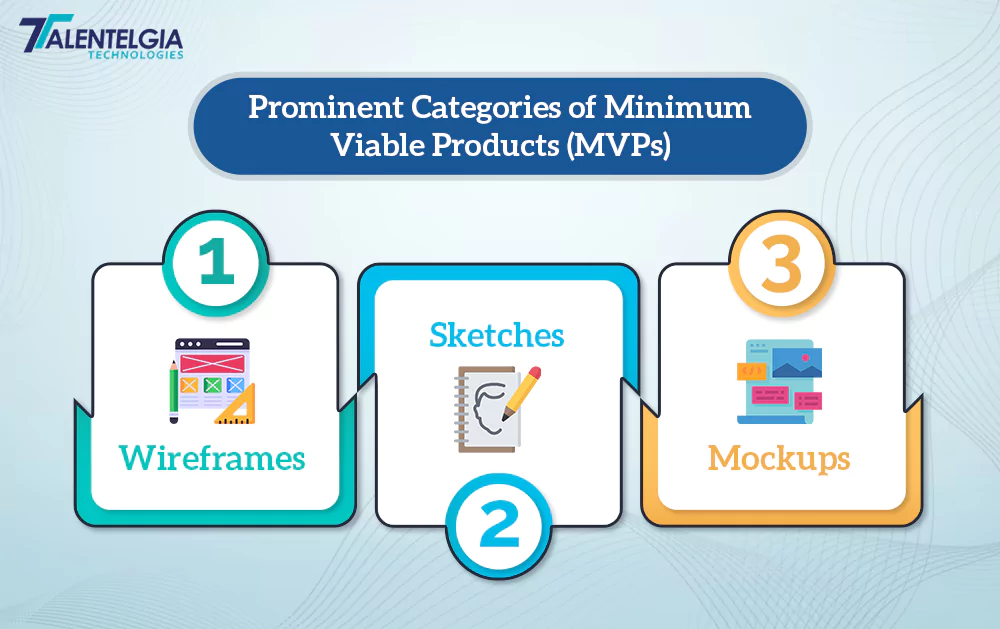
Now explore various popular categories of MVPs to consider for your company:
- Wireframes
Wireframes, also known as UX wireframes, are a series of design sketches that form the basic structure of a system. They adhere to the design principles of specific platforms like Android, iOS, or the web.
For example, wireframes illustrate the layout of the system, the product’s features, and how users navigate between screens.
- Sketches
Sketches are hand-drawn representations of systems, and they can sometimes be created using tools like Proto.io or Balsamiq.
These sketches highlight the major screens or web pages of the envisioned product along with its core functionality. They can be used to showcase unique ideas, seek crowdfunding, or attract potential investors.
- Mockups
UI mockups are full-sized, colorful depictions of product designs ready for software implementation. They serve various purposes, including evaluation, demonstration, fundraising, and promotion, and are quite similar to UX wireframes.
Clickable mockups can be generated to facilitate MVP testing of user interactions with a future mobile app or website.
Successful MVP Examples and Case Studies
Numerous renowned products and companies trace their origins to MVPs that were introduced to huge demand and viability.
Notable examples include:
- Dropbox: a cloud storage and file-sharing service, began its journey with a basic video showcasing how it works. Today, Dropbox boasts over 600 million users and is valued at a staggering $10 billion.
- Airbnb: Airbnb, the global online marketplace connecting travelers with accommodation and experiences, began by listing three air mattresses in the founders’ apartment during a conference in San Francisco. Three guests paid $80 each for a night’s stay, marking the inception of a global phenomenon.
- Uber: Uber, the ride-hailing giant operating in thousands of cities and numerous countries with an $86 billion valuation, launched as a mobile app allowing users to request black car services in San Francisco. It initially served the founders and their friends before expanding to a broader user and driver network.
Best Practices for Successful MVP Development
Building an MVP for a Core Set of Users
Developing an MVP for a targeted user base helps refine findings through iterative updates. Identifying customers, understanding their needs, and conducting surveys contribute to the success of the app.
Market Research
To define target demographics, understand user backgrounds, needs, and device preferences. Create user stories based on findings to uncover pain points and distinguish your product from competitors.
Creating a Product Roadmap
A dynamic product roadmap guides Android app development strategically. Begin with product discovery to articulate the product’s mission, target users, and unique value proposition. Adapt the roadmap to accommodate ongoing changes.
Design Process & User Flow
Design the app with user convenience in mind, focusing on the entire user journey. Define user flow stages to ensure a seamless experience, emphasizing basic tasks aligned with end-users’ goals.
Prioritizing Features for an MVP
Identify the core problem users face and prioritize features accordingly. Create a master wishlist, use the MoSCoW matrix for prioritization, and limit features for the MVP to streamline development and prevent scope creep.
Build, Gather Feedback, Measure, and Make Iterations
Create an MVP that fulfills user needs, keeping it easy to use and engaging. Collect user feedback after launch to identify areas of improvement. Iteratively develop and adjust the product roadmap based on real user feedback to meet market demands efficiently.
Challenges in MVP Development and Effective Solutions
Undefined Goals and Scope
Challenge: Lack of clarity on goals and scope can hinder MVP development.
Solution: Comprehensive consultations are conducted to define clear goals, identify the target audience, and outline necessary features. This ensures a well-defined roadmap for successful product development.
Resource Constraints
Challenge: Resource limitations, including budget and time constraints, can impact MVP development.
Solution: Prioritizing features based on impact and necessity optimizes resources. This approach accelerates development timelines and offers a cost-effective solution for startups and businesses with resource constraints.
Technical Challenges
Challenge: Complex technical requirements may pose challenges during MVP development.
Solution: A diverse and skilled team tackles technical challenges through a phased approach. This includes breaking down complex features and ensuring step-by-step implementation aligned with the development team’s capabilities while maintaining a focus on quality.
User Feedback and Iteration
Challenge: Gathering meaningful user feedback and incorporating iterative improvements can be challenging without a streamlined feedback mechanism.
Solution: Advocating for an iterative development process with regular feedback loops, we implement analytics tools, conduct user testing, and gather feedback through various channels. This ensures continuous improvement based on user preferences and needs.
Market Timing
Challenge: Determining the right time to launch the MVP is a delicate balance.
Solution: Guiding you in adopting a strategic approach to market timing, we conduct market research, monitor industry trends, and adapt as needed. This assistance helps in finding the optimal launch window for your MVP, aligning with market demands.
Scalability Challenges
Challenge: Scalability issues may arise if the initial architecture is not designed to handle growth.
Solution: Emphasizing a scalable architecture from the outset, we plan for potential growth and build a foundation that can accommodate increased user demands. Regularly evaluating and upgrading your infrastructure ensures seamless scalability as your MVP gains traction.
How Much Does an MVP Cost?
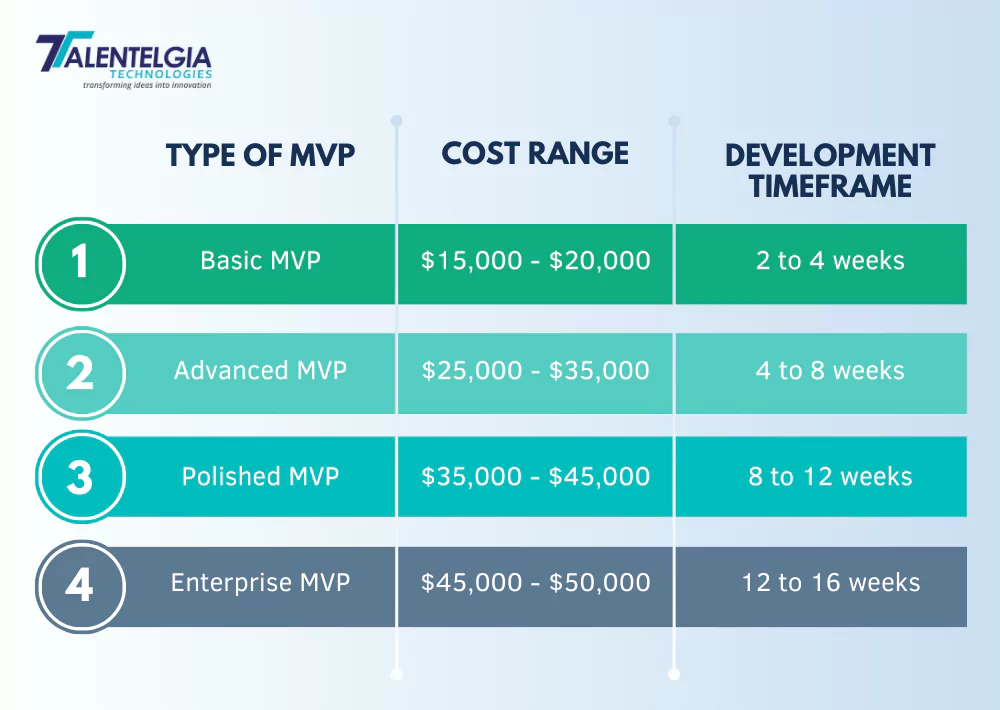
The cost of an MVP hinges on numerous factors, such as product complexity, features, development approach, technology stack, time investment, and quality expectations. While pinpointing an exact cost is challenging, estimates fall within a range:
Managing Budget and Timeline for Startups
Sell Your Product
Whether your concept is just an idea or an exceptional product, focus on selling it. The monetization strategy can determine the success or failure of your concept. Be mindful of the cost associated with making your product known, aiming for at least breaking even.
Avoid the Common Mistake
The primary mistake made by technical founders is excessive focus on building without adequate promotion. Even with impeccable code and user-friendly design, lack of visibility can lead to obscurity. Balancing development with marketing efforts is crucial to avoid the trap of unnoticed existence.
Challenges in Subscription Models
While subscription models offer long-term benefits, they come with complexities. The user’s lifetime value, spread over smaller payments, delays the return on marketing investment. Subscription models demand careful planning, as the sales process takes time and requires significant investment for scaling.
Strategic Planning for MVP Features
Choose the Right Features for Your MVP
Carefully observe competitors and understand that numerous features may not necessarily be essential. Focus on solving a specific problem better than others. Prioritize features based on importance and difficulty, avoiding unnecessary complexity until validated as essential.
Start With the Right Platform
Selecting the appropriate platform is crucial. Avoid launching on multiple platforms simultaneously, as it escalates costs and complexity. Choose the platform based on the product’s nature and target audience, ensuring adaptability for future scaling.
Avoid Over-Engineering but Plan for Scalability
Strike a balance between avoiding over-engineering and preparing for scalability. Understand the nature of your product and choose an architecture that is scalable without unnecessary complexity. Consider NoSQL databases for flexibility and scalability, opting for database-as-a-service solutions where applicable.
Focus on User Experience
Prioritize core functionality for an effective MVP launch. Keep design simple and modern, utilizing existing design systems to streamline development. Ensure user experience is intuitive, conduct usability tests, and gather feedback to refine the design for optimal user satisfaction.
Assemble the Right Team
Building the right team is crucial for startup success. Form a team with diverse skills, including marketing, sales, UX design, and product development. The team size should be optimal for effective communication and management, striking a balance between expertise and efficiency.
Freelancers vs. Company vs. In-House
Consider different approaches for assembling your team. Freelancers offer cost-effectiveness but require more management effort. Specialized companies provide expertise and flexibility, while in-house development offers in-person communication and strong team relationships. Each approach has its pros and cons, catering to various project needs.
Conclusion
In conclusion, we’ve detailed the steps required for planning and crafting an MVP and what are the key information you may need in crafting an MVP. This encompasses defining the problem, identifying solutions, feature prioritization, prototype creation, and MVP launch. Additionally, we’ve provided insights into estimating costs and streamlining the efficiency of your MVP development process.
Lastly, we’ve shared guidance on selecting the ideal MVP development partner for your project. This involves assessing their portfolio, expertise, communication prowess, and reviews. We trust that this article offers a comprehensive understanding of MVP development services and their potential to align with your business objectives.
We also hope that the provided information will contribute to your MVP’s success.
Frequently Asked Questions Regarding MVP Development Services
In this section, we address common questions related to MVP development services:
1. How does MVP apply when developing a service?
When developing a service, Minimum Viable Product (MVP) methodology involves creating a simplified version of the service with essential features. This allows testing the service’s viability and collecting user feedback before investing in full-scale development.
2. How long does MVP development take?
The duration of MVP development varies based on the complexity of the service and the features included. On average, it can take several weeks to a few months. The emphasis is on delivering a functional prototype swiftly to gather valuable insights from user interactions.
3. Should MVP be avoided for product development?
No, MVP is a valuable approach for product development. It enables businesses to minimize risks by validating ideas and features early in the process. Developing an MVP provides a cost-effective way to test the market and refine the product based on user feedback before investing extensively.
4. What is the MVP development cycle?
The MVP development cycle involves several stages:
- Market Research: Understand user needs and market demands.
- Feature Identification: Determine essential features for the initial version.
- Design: Create a user-friendly design with core functionalities.
- Development: Build the basic version of the service.
- Testing: Deploy the MVP to a limited audience for feedback.
- Refinement: Make necessary improvements based on user responses.
- Scaling: Implement additional features and scale up for full development if validated.
This iterative process ensures continuous improvement and alignment with user expectations throughout the development journey.


 Healthcare App Development Services
Healthcare App Development Services
 Real Estate Web Development Services
Real Estate Web Development Services
 E-Commerce App Development Services
E-Commerce App Development Services E-Commerce Web Development Services
E-Commerce Web Development Services Blockchain E-commerce Development Company
Blockchain E-commerce Development Company
 Fintech App Development Services
Fintech App Development Services Fintech Web Development
Fintech Web Development Blockchain Fintech Development Company
Blockchain Fintech Development Company
 E-Learning App Development Services
E-Learning App Development Services
 Restaurant App Development Company
Restaurant App Development Company
 Mobile Game Development Company
Mobile Game Development Company
 Travel App Development Company
Travel App Development Company
 Automotive Web Design
Automotive Web Design
 AI Traffic Management System
AI Traffic Management System
 AI Inventory Management Software
AI Inventory Management Software
 AI Software Development
AI Software Development  AI Development Company
AI Development Company  AI App Development Services
AI App Development Services  ChatGPT integration services
ChatGPT integration services  AI Integration Services
AI Integration Services  Generative AI Development Services
Generative AI Development Services  Natural Language Processing Company
Natural Language Processing Company Machine Learning Development
Machine Learning Development  Machine learning consulting services
Machine learning consulting services  Blockchain Development
Blockchain Development  Blockchain Software Development
Blockchain Software Development  Smart Contract Development Company
Smart Contract Development Company  NFT Marketplace Development Services
NFT Marketplace Development Services  Asset Tokenization Company
Asset Tokenization Company DeFi Wallet Development Company
DeFi Wallet Development Company Mobile App Development
Mobile App Development  IOS App Development
IOS App Development  Android App Development
Android App Development  Cross-Platform App Development
Cross-Platform App Development  Augmented Reality (AR) App Development
Augmented Reality (AR) App Development  Virtual Reality (VR) App Development
Virtual Reality (VR) App Development  Web App Development
Web App Development  SaaS App Development
SaaS App Development Flutter
Flutter  React Native
React Native  Swift (IOS)
Swift (IOS)  Kotlin (Android)
Kotlin (Android)  Mean Stack Development
Mean Stack Development  AngularJS Development
AngularJS Development  MongoDB Development
MongoDB Development  Nodejs Development
Nodejs Development  Database Development
Database Development Ruby on Rails Development
Ruby on Rails Development Expressjs Development
Expressjs Development  Full Stack Development
Full Stack Development  Web Development Services
Web Development Services  Laravel Development
Laravel Development  LAMP Development
LAMP Development  Custom PHP Development
Custom PHP Development  .Net Development
.Net Development  User Experience Design Services
User Experience Design Services  User Interface Design Services
User Interface Design Services  Automated Testing
Automated Testing  Manual Testing
Manual Testing  Digital Marketing Services
Digital Marketing Services 
 Ride-Sharing And Taxi Services
Ride-Sharing And Taxi Services Food Delivery Services
Food Delivery Services Grocery Delivery Services
Grocery Delivery Services Transportation And Logistics
Transportation And Logistics Car Wash App
Car Wash App Home Services App
Home Services App ERP Development Services
ERP Development Services CMS Development Services
CMS Development Services LMS Development
LMS Development CRM Development
CRM Development DevOps Development Services
DevOps Development Services AI Business Solutions
AI Business Solutions AI Cloud Solutions
AI Cloud Solutions AI Chatbot Development
AI Chatbot Development API Development
API Development Blockchain Product Development
Blockchain Product Development Cryptocurrency Wallet Development
Cryptocurrency Wallet Development About Talentelgia
About Talentelgia  Our Team
Our Team  Our Culture
Our Culture 
 Healthcare App Development Services
Healthcare App Development Services Real Estate Web Development Services
Real Estate Web Development Services E-Commerce App Development Services
E-Commerce App Development Services E-Commerce Web Development Services
E-Commerce Web Development Services Blockchain E-commerce
Development Company
Blockchain E-commerce
Development Company Fintech App Development Services
Fintech App Development Services Finance Web Development
Finance Web Development Blockchain Fintech
Development Company
Blockchain Fintech
Development Company E-Learning App Development Services
E-Learning App Development Services Restaurant App Development Company
Restaurant App Development Company Mobile Game Development Company
Mobile Game Development Company Travel App Development Company
Travel App Development Company Automotive Web Design
Automotive Web Design AI Traffic Management System
AI Traffic Management System AI Inventory Management Software
AI Inventory Management Software AI Software Development
AI Software Development AI Development Company
AI Development Company ChatGPT integration services
ChatGPT integration services AI Integration Services
AI Integration Services Machine Learning Development
Machine Learning Development Machine learning consulting services
Machine learning consulting services Blockchain Development
Blockchain Development Blockchain Software Development
Blockchain Software Development Smart contract development company
Smart contract development company NFT marketplace development services
NFT marketplace development services IOS App Development
IOS App Development Android App Development
Android App Development Cross-Platform App Development
Cross-Platform App Development Augmented Reality (AR) App
Development
Augmented Reality (AR) App
Development Virtual Reality (VR) App Development
Virtual Reality (VR) App Development Web App Development
Web App Development Flutter
Flutter React
Native
React
Native Swift
(IOS)
Swift
(IOS) Kotlin (Android)
Kotlin (Android) MEAN Stack Development
MEAN Stack Development AngularJS Development
AngularJS Development MongoDB Development
MongoDB Development Nodejs Development
Nodejs Development Database development services
Database development services Ruby on Rails Development services
Ruby on Rails Development services Expressjs Development
Expressjs Development Full Stack Development
Full Stack Development Web Development Services
Web Development Services Laravel Development
Laravel Development LAMP
Development
LAMP
Development Custom PHP Development
Custom PHP Development User Experience Design Services
User Experience Design Services User Interface Design Services
User Interface Design Services Automated Testing
Automated Testing Manual
Testing
Manual
Testing About Talentelgia
About Talentelgia Our Team
Our Team Our Culture
Our Culture
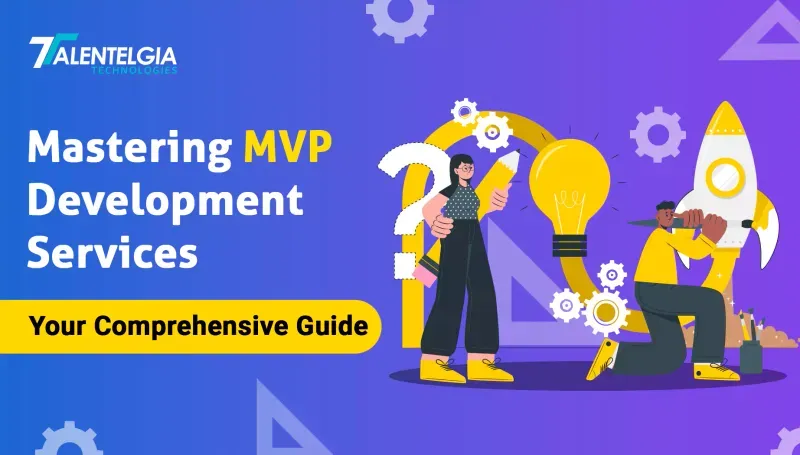

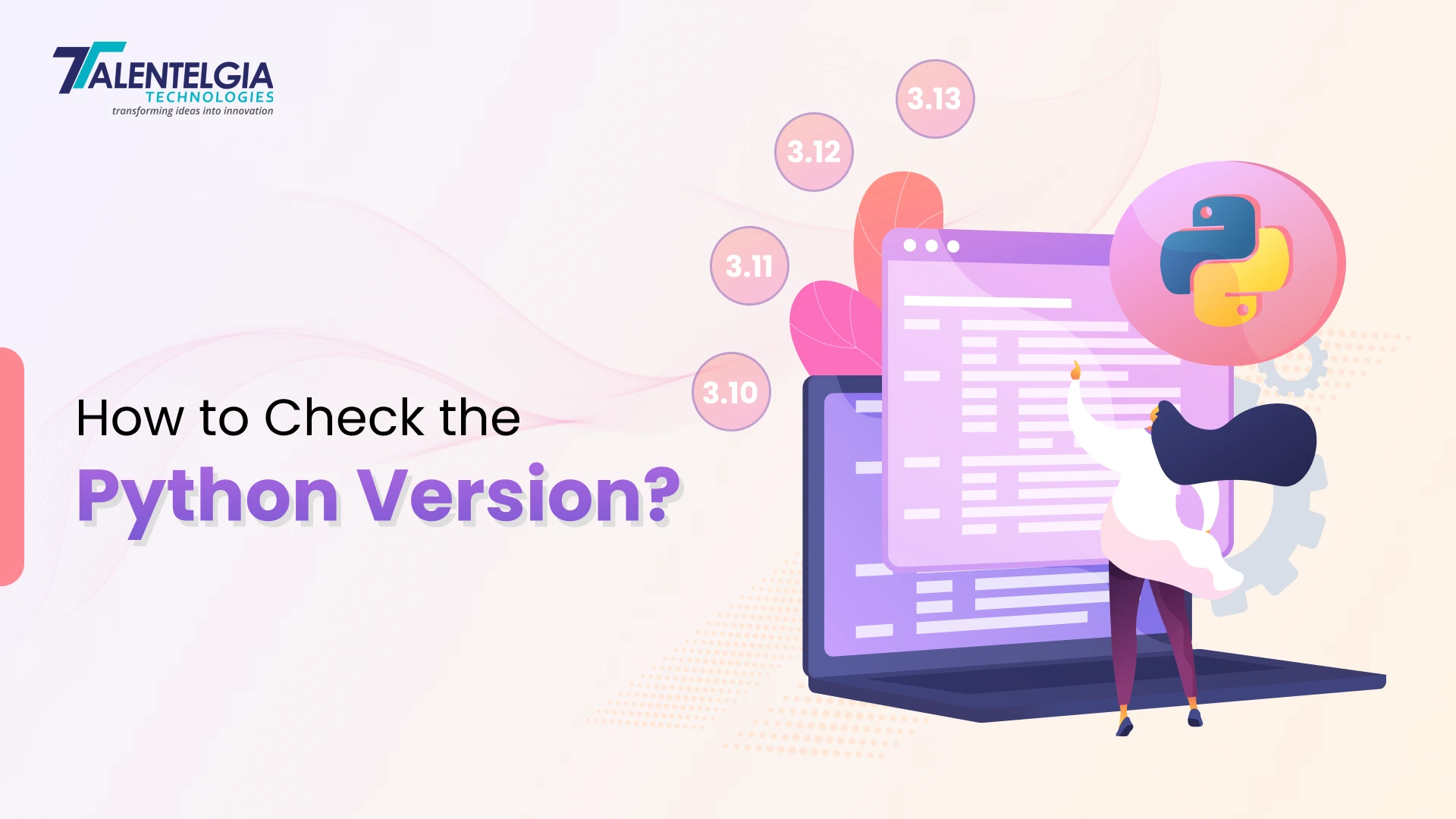

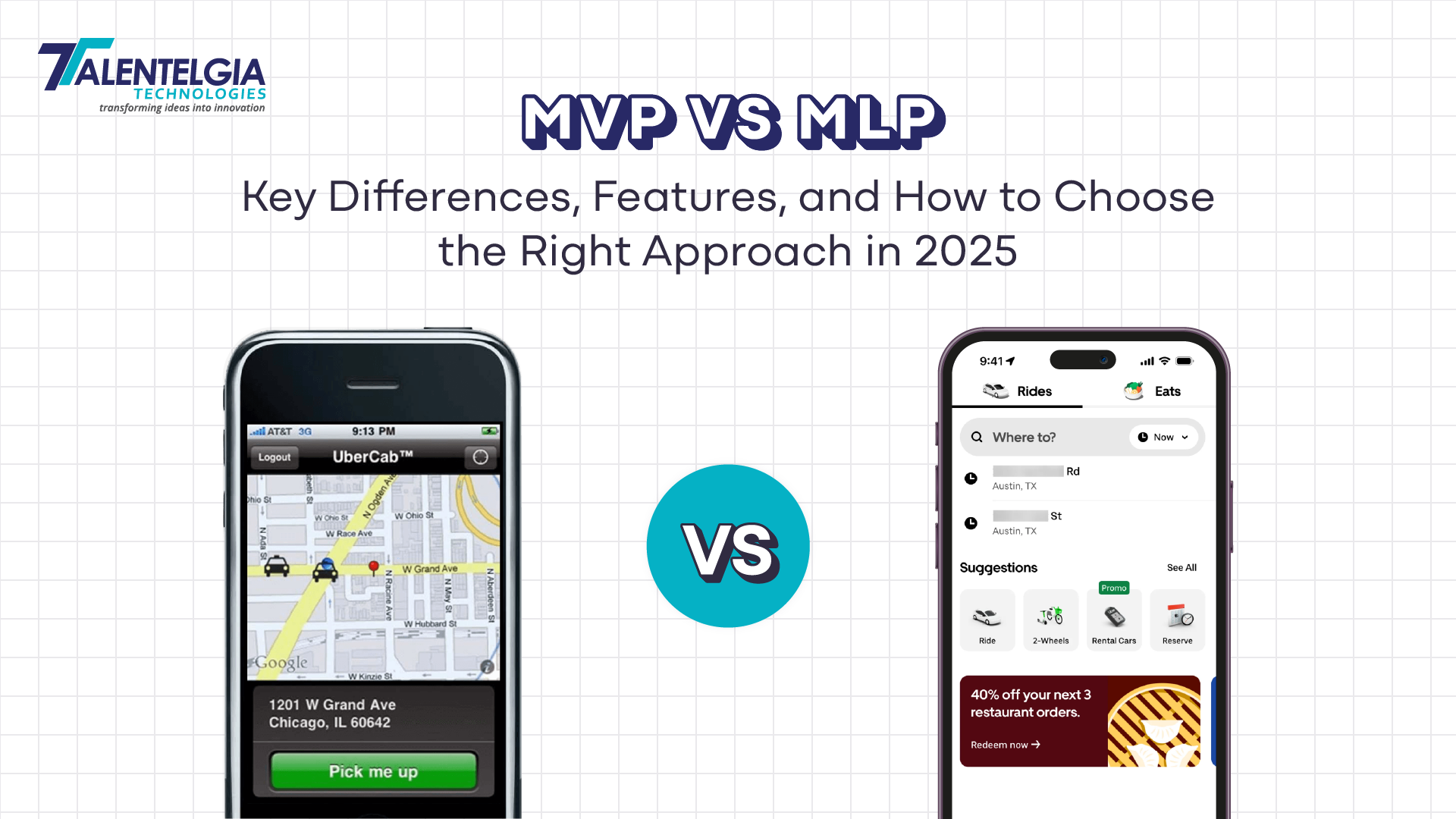
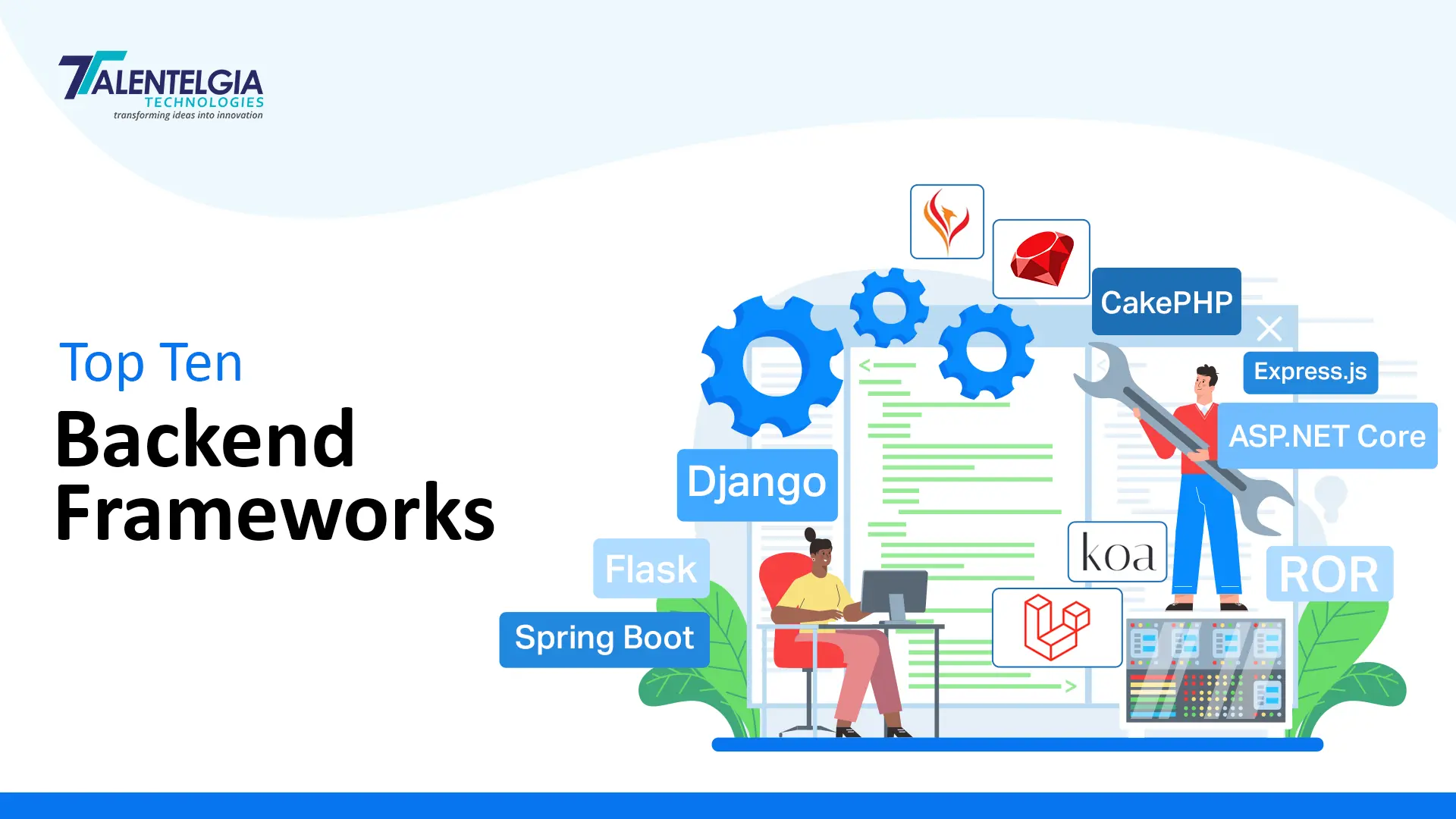











 Write us on:
Write us on:  Business queries:
Business queries:  HR:
HR: 




